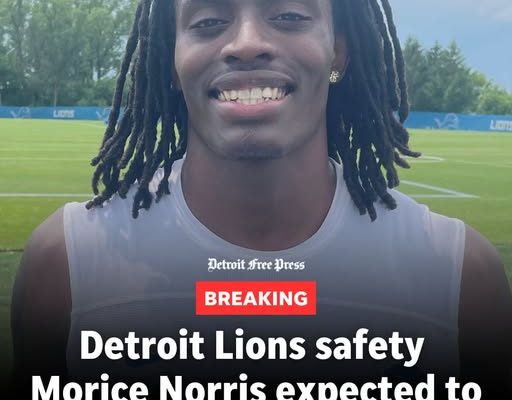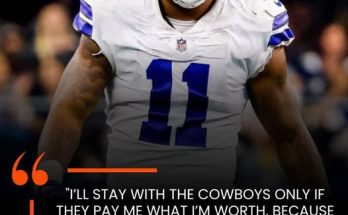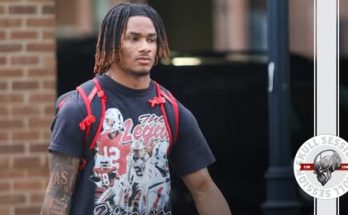Detroit Lions safety Morice Norris gave fans and teammates quite a scare after he spent the night at Atlanta’s Grady Memorial Hospital for evaluation of potential brain, neck, and spine injuries. The incident, which unfolded late Friday evening, left many wondering about his long-term health and whether it would impact his availability for the upcoming season. In a sport where physical collisions are part of the daily reality, any injury involving the head, neck, or spine is taken extremely seriously, not only because of its potential to end a player’s career but also because of the permanent life-altering consequences it can bring. The 25-year-old defensive back, however, sought to calm fears by posting a reassuring message to his Instagram story on Saturday, stating simply, “I’m all good man,” signaling to supporters that the worst-case scenarios had been avoided. While his brief message was enough to give a sigh of relief to many, the situation has opened conversations about the physical demands of the NFL, the risks inherent in the game, and the critical importance of thorough medical evaluations after hard hits.
According to team sources, Norris was injured during a team-related workout and experienced symptoms that prompted medical personnel to recommend immediate transport to the hospital. Grady Memorial Hospital, known for its top-tier trauma care, is a go-to facility in Atlanta for urgent cases involving serious injuries. Upon arrival, Norris underwent a battery of tests, including neurological exams, imaging scans such as MRIs and CT scans, and spine assessments to rule out fractures, concussions, or spinal cord involvement. NFL medical protocols require that any player exhibiting symptoms related to the central nervous system—such as dizziness, loss of sensation, or neck stiffness—be removed from physical activity immediately and evaluated by specialists. The fact that Norris was kept overnight underscores the cautious approach taken, even when preliminary results suggest no severe structural damage.
For Norris, who is entering a pivotal season in his young NFL career, the timing of this scare could have been much worse. Preseason is just around the corner, and training camp intensity is at its peak, meaning that every practice rep counts. Coaches want their players sharp and conditioned, but also safe, and no team can afford to rush someone back from an injury that involves the spine or brain. NFL history is filled with cautionary tales of athletes who returned too soon and suffered long-term consequences. Concussions and neck injuries have derailed promising careers, and in some cases, they have altered players’ lives far beyond football. This is why the Lions’ medical and coaching staff will undoubtedly continue to monitor Norris closely in the days ahead, even if he has been cleared to resume non-contact activities.
Fans on social media reacted to the news with a mix of worry and relief. Some expressed gratitude that Norris was receiving the best medical care possible, while others were quick to highlight how fragile a football career can be. In the modern era of the NFL, where awareness of traumatic brain injuries is higher than ever, the emphasis on immediate evaluation cannot be overstated. The NFL’s concussion protocol, which has evolved significantly over the past decade, mandates that players suspected of head injuries undergo strict testing and cannot return to play until cleared by independent neurologists. While it’s unclear if Norris sustained a concussion in this instance, his evaluation for brain trauma alone signals that the Lions were treating the incident with maximum seriousness.
For those unfamiliar with Norris’s journey, he’s a young safety known for his hard-hitting style and keen defensive instincts. His physical approach to the game, while a key strength, naturally exposes him to a higher level of collision risk. Players in his position are often tasked with stopping ball carriers at full speed, tackling large tight ends, and occasionally blitzing quarterbacks—all of which put stress on the body, especially the head and neck area. In many ways, his injury scare is a reminder of how quickly a routine play or drill can turn dangerous. The human body, even at peak athletic conditioning, is still vulnerable to the physics of high-speed contact.
Teammates were quick to rally around him. Several Lions players sent messages of support online, emphasizing how much Norris means to the locker room both as a competitor and as a person. While fans mostly see the on-field product, the brotherhood inside an NFL roster is built on daily grind, shared adversity, and mutual trust. An injury to one player—especially one involving something as potentially devastating as the brain or spine—hits home for everyone. Players know that at any moment, their careers could change with one wrong hit. It’s this reality that makes each player’s health scare resonate deeply inside the team.
From a broader perspective, Norris’s incident is part of an ongoing dialogue in the NFL about player safety. League officials have been working to refine equipment, update rules, and improve medical protocols to better protect players from head and spine injuries. While the helmet technology today is more advanced than ever, no equipment can completely eliminate the risk of concussions or spinal damage. The league has also introduced stricter penalties for dangerous hits, particularly those targeting the head or neck area, but the speed and intensity of the game still make it impossible to remove the risk entirely. Norris’s overnight stay in the hospital is a testament to why those safety measures exist and why they are constantly being reevaluated.
The Detroit Lions have not released an official statement detailing exactly how the injury occurred, but insiders suggest it was a combination of awkward body positioning and sudden contact during a training drill. In football, injuries can happen even without violent collisions—an unexpected twist of the neck, whiplash motion, or compression of the spine can be enough to cause serious concern. Medical professionals who deal with athletes often stress that symptoms may not present immediately, which is why overnight observation is common in suspected neurological or spinal cases. Monitoring allows doctors to catch delayed swelling, bleeding, or nerve response issues before they worsen.
In the aftermath of the scare, Norris’s quick decision to address his followers directly on Instagram speaks to the modern reality of professional sports, where athletes often control the narrative around their health. His simple message—“I’m all good man”—was short, casual, and reassuring, but it also left room for fans to interpret that he’s ready to get back to work. While it may be tempting to see this as the end of the story, most football professionals would advise that even minor symptoms should be monitored closely over the next few weeks. Recovery is not always about immediate clearance; it’s about ensuring that no lingering effects compromise performance or safety later in the season.
As the Lions prepare for their next phase of training, the coaching staff will likely adjust Norris’s workload to give him ample recovery time. In the NFL, long-term durability often depends on how well a player and his team handle the small warning signs before they become major injuries. If Norris feels any residual stiffness, headaches, or numbness, he will be expected to speak up immediately, and the Lions’ medical team will intervene as needed. With a full regular season ahead, the organization’s priority will be to keep him healthy for the games that matter most, especially given his potential role in the secondary.
Injuries are an unavoidable part of the NFL, but moments like this put into perspective just how thin the line is between peak athletic performance and the fragility of the human body. While fans cheer for big hits and physical dominance on Sundays, those same collisions can carry consequences that linger far beyond the final whistle. For Morice Norris, the hope is that this incident is nothing more than a precautionary tale—a brief, frightening moment that ends with him back on the field stronger than ever. For the Lions, it’s a reminder to protect their players, invest in their health, and treat every injury with the seriousness it deserves. And for the fans, it’s another reason to appreciate the resilience, toughness, and risk these athletes face every single time they step onto the field.
If anything, the past 24 hours have shown that the bonds between players, teams, and supporters run deep. Norris’s hospital stay sparked concern, but it also revealed the support network that surrounds every professional athlete. From teammates checking in to fans flooding his social media with well wishes, it was a moment that transcended the usual wins and losses of the sport. Football may be about competition, but in moments like these, it becomes about humanity—about ensuring that these athletes who entertain millions can walk away from the game with their health intact. Norris’s story, at least for now, appears to be heading toward a happy resolution, and that’s something everyone connected to the Lions can celebrate.



